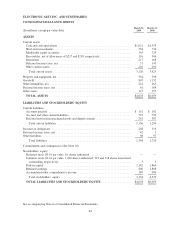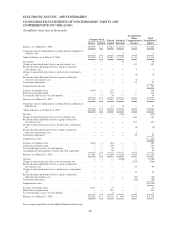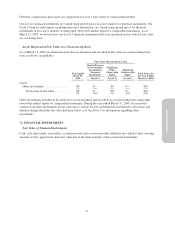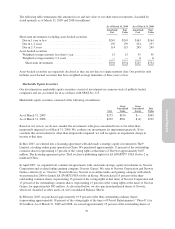Electronic Arts 2009 Annual Report Download - page 152
Download and view the complete annual report
Please find page 152 of the 2009 Electronic Arts annual report below. You can navigate through the pages in the report by either clicking on the pages listed below, or by using the keyword search tool below to find specific information within the annual report.specific objective evidence of fair value (“VSOE”) exists for each undelivered element, and (4) allocate the total
price among the various elements we must deliver. Changes to any of these assumptions or management
judgments, or changes to the elements in a software arrangement, could cause a material increase or decrease in
the amount of revenue that we report in a particular period. For example, in connection with some of our
packaged goods product sales, we offer an online service without an additional fee. Prior to fiscal year 2008, we
were able to determine VSOE for the online service to be delivered; therefore, we were able to allocate the total
price received from the combined product and online service sale between these two elements and recognize the
related revenue separately. However, starting in fiscal year 2008, VSOE no longer existed for the online service
to be delivered for certain platforms and all revenue from these transactions is recognized over the estimated
online service period. More specifically, starting in fiscal year 2008, we began to recognize the revenue from
sales of certain online-enabled packaged goods on a straight-line basis over a six month period beginning in the
month after shipment. Accordingly, this relatively small change (from having VSOE for the online service to no
longer having VSOE) has had a significant effect on our reported results.
In addition, for some software products we also provide updates or additional content (“digital content”) to be
delivered via the Internet that can be used with the original software product. In many cases we separately sell
digital content for an additional fee; however some purchased digital content can only be accessed via the
Internet (i.e., the consumer never takes possession of the digital content). We account for online transactions in
which the consumer does not take possession of the digital content as a service transaction and, accordingly, we
recognize the associated revenue over the estimated service period. In other transactions, at the date we sell the
software product we have an obligation to provide incremental unspecified digital content in the future without
an additional fee. In these cases, we account for the sale of the software product as a multiple element
arrangement and recognize the revenue on a straight-line basis over the estimated life of the game.
Determining whether a transaction constitutes an online service transaction or a digital content download of a
product requires management judgment and can be difficult. The accounting for these transactions is
significantly different. Revenue from product downloads is generally recognized when the download is made
available (assuming all other recognition criteria are met). Revenue from an online game service is recognized as
the service is rendered. If the service period is not defined, we recognize the revenue over the estimated service
period. Determining the estimated service period is inherently subjective and is subject to regular revision based
on historical online usage. In addition, determining whether we have an implicit obligation to provide
incremental unspecified future digital content without an additional fee for our software products can be difficult.
Product Revenue: Product revenue, including sales to resellers and distributors (“channel partners”), is
recognized when the above criteria are met. We reduce product revenue for estimated future returns, price
protection, and other offerings, which may occur with our customers and channel partners.
Shipping and Handling: In accordance with Emerging Issues Task Force (“EITF”) Issue No. 00-10, Accounting
for Shipping and Handling Fees and Costs, we recognize amounts billed to customers for shipping and handling
as revenue. Additionally, shipping and handling costs incurred by us are included in cost of goods sold.
Online Subscription Revenue: Online subscription revenue is derived principally from subscription revenue
collected from customers for online play related to our massively multiplayer online games and Pogo-branded
online games services. These customers generally pay on an annual basis or a month-to-month basis and prepaid
subscription revenue is recognized ratably over the period for which the services are provided.
Software Licenses: We license software rights to manufacturers of products in related industries (for example,
makers of personal computers or computer accessories) to include certain of our products with the
manufacturer’s product, or offer our products to consumers who have purchased the manufacturer’s product. We
call these combined products “OEM bundles.” These OEM bundles generally require the customer to pay us an
upfront nonrefundable fee, which represents the guaranteed minimum royalty amount. Revenue is generally
recognized upon delivery of the product master or the first copy. Per-copy royalties on sales that exceed the
minimum guarantee are recognized as earned.
72
























